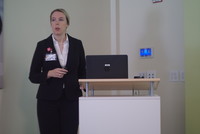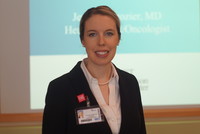

Ponte Vedra YMCA’s Y Healthy Living Center hosted another in its series of “Talk with a Doc” events Oct. 20, this time covering lifestyle links to breast health.
Jennifer Crozier, MD, a hematologist oncologist from Baptist MD Anderson Cancer Center, presented a slideshow detailing breast health information ranging from risks to prevention and lifestyle changes.
Dr. Crozier says that although breast cancer rates have been declining since 1989, it remains the number one cancer amongst women.
“Unfortunately, there’s no sure way to prevent breast cancer,” she said. “But there are some things that all women can do to try and reduce their risk. Our goal is to be finding these cancers at an earlier stage when they’re more treatable and more curable.”
Identifying four major steps to bettering breast health, she stressed the importance of screening, weight control, healthy dietary choices and physical activity to reduce the risk of breast cancer.
Screening
“Screening helps find cancers usually at an earlier stage, before they’ve spread and when they’re usually more curable with surgery, possibly chemotherapy and radiation therapy,” Crozier said, noting that the earlier the cancer is found the better.
Though the American Cancer Society recommends discussing when screening may be right for the patient once they turn 40 with yearly mammograms beginning at age 45, she recommends sooner, more frequent checks.
“(At Anderson), we think that’s a little on the conservative side,” she said. “We start at age 40, that’s typically our recommendation. Starting at age 40 and continuing annually from there.”
Crozier also noted that they rarely recommend screening every other year beginning at age 55 as the American Cancer Society does because it may increase the likelihood of women forgetting to follow-up at the next scheduled appointment.
“I’ve noticed that sometimes that ends up being three years or two and a half -- patients really start to push things out,” she said. “If it’s an annual thing and patients know that their mammo is due every October or around their birthday every year, it’s easier to remember.”
The annual mammograms give doctors better consistency and allow them to see the image over time, which in turn makes it easier to notice more subtle changes and catch things earlier. Likewise, Crozier says that they don’t consider women over 55 years of age at a “stop point” for mammograms.
“As long as a woman’s in good health otherwise, we continue to do mammograms as long as she can tolerate some sort of surgery in order to have the cancer removed,” she said.
Self-exams are recommended so long as they don’t provoke anxiety, she said, and she encourages women to be familiar enough with the way their breasts look and feel so they’ll be able to notice any significant changes.
Weight control
More than two in three American adults are overweight, and more than one in three are obese. Among children and teens aged two to 19, nearly one in six are obese. Crozier says that it’s important to consider body mass index (BMI) because studies have shown that as BMI increases, the risk of getting breast cancer increases as well. Getting to a healthy weight as young as possible and maintaining it as long as possible is key, she says, but it’s never too late to try and reach a healthy weight.
Studies have shown that incorporating physical activity into the day and choosing healthier diet options, in addition to assisting with weight loss, can reduce the risk of breast cancer as well.
Physical activity
Crozier says that studies have shown that breast cancer is reduced amongst physically active women compared to less active women. One collection of studies showed that breast cancer was reduced 25% among physically active women compared to the least active women, and a lifetime total of physical activity has been associated with decreased risk of both breast cancer and passing away from the disease.
“We recommend that you get at least 150 minutes of moderate intensity or 75 minutes of vigorous activity each week, or an equivalent combination throughout the week,” Crozier said, noting that personal responsibilities might make it difficult to get continuous exercise. “Even doing them in different intervals is usually about the same. Perhaps not for weight loss, but the health benefits in terms of cancer, diabetes and the heart, is likely equivalent in 15 to 20 minute sets.”
She added that limiting sedentary behavior -- sitting, lying down and “screen-based” activities -- and getting any amount of physical activity above the usual level can have health benefits.
Two to three times a week, try a recreational activity such as gardening or housekeeping. Exercises like yoga and light weight lifting should be practiced just as frequently. And three to five times a week try an aerobic activity at 20 minute intervals, such as swimming or cycling.
But, as Crozier said, it’s worth it to try to fit in exercise everyday where possible by doing things like taking the longest route to and from the office building, walking the dog and taking stairs instead of the elevator.
Dietary choices
“What we really want to do is rearrange the plate by promoting a plant-based diet where fruits and vegetables are the center and the side items are protein, meats and whole grains,” Crozier said. “Choosing foods and beverages in the right amounts can help achieve a healthy weight.”
Likewise, women who consume more servings of vegetables see lowered risk of breast cancer compared to women who consume too few. According to Crozier, meta-analysis of several studies have shown a link between high consumption of vegetables and reduction of risk. The increased intake of fruits and vegetables is linked to total health benefits and reduced risk with all cancers, in heart health and diabetes and stroke -- not only breast cancer.
She suggested limiting the intake of sugary beverages like soda and sports drinks so as not to negate the effects of a healthy diet and physical activity. More importantly, Crozier strongly suggested limiting alcohol to one drink per day for women and two for men (where either 12 ounces of beer, one and a half ounces of spirits or five ounces of wine constitutes one drink).
In addition, try to establish good eating techniques even away from home by being mindful of foods in restaurants with large portion sizes and opting instead to pack lunch while out our travelling.
Limit processed meat (bacon, sausage, hot dogs, etc.) and choose fish as a protein-alternative to meats. And when eating red meats, try to choose leaner cuts -- and opt to bake, broil or poach instead of frying or charbroiling.
Overall, Crozier urged attendees to take charge by maintaining a healthy, balanced lifestyle and managing risks where possible.
“These are the things you can do -- being active, maintaining a healthy weight and being aware of our breasts and any changes,” she said. “Limit your risks and get screened every year.”